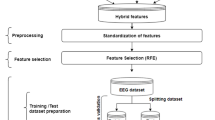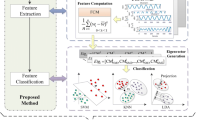Abstract
Epilepsy is a chronic neurological disorder that involves abnormal electrical signal patterns of the brain called seizures. The brain’s electrical signals can be recorded using an electroencephalogram (EEG). EEG recordings can be used to monitor complex and non-stationary signals produced by the brain for detecting epilepsy seizures. Machine learning (ML) methods have been successfully applied in different domains to accurately classify the patterns based upon dataset features. However, ML methods are unable to analyze the raw EEG signals. Appropriate features must be extracted from EEG recordings for detecting epilepsy seizures using signal processing methods. This work proposes an intelligent system by integrating variational mode decomposition (VMD) and Hilbert transform (HT) method for extracting useful features from EEG signals and stacked neural network (NN) method for detecting epilepsy seizures. VMD method decomposers EEG signals into intrinsic mode functions, followed by the HT method for extracting features from EEG signals. The stacked-NN approach is applied for detecting epilepsy seizures using extracted features. The performance of the proposed system is validated using benchmark datasets for epilepsy seizure detection provided by Bonn University and, Neurology and Sleep Centre, New Delhi (NSC-ND). The performance of the proposed system is compared with other ML methods and state of the art approaches in the field. The reported results demonstrate that the proposed system can detect up to 100% accurate epilepsy seizures using NSC-ND data set and up to 99% accurate epilepsy seizures using Bonn university dataset. The comparative results also demonstrate the better performance of the proposed system over other ML methods and existing approaches for detecting epilepsy seizures. The remarkable performance of the proposed system can help neurological experts to detect epilepsy seizures accurately using EEG signals and can be embedded into the real-time diagnosis of the disease.



Similar content being viewed by others
References
Abualigah L, Diabat A, Mirjalili S, Abd Elaziz M, Gandomi AH (2021) The arithmetic optimization algorithm. Comput Methods Appl Mech Eng 376
Abualigah L, Diabat A, Sumari P, Gandomi AH (2021) Applications, deployments, and integration of internet of drones (iod): a review. IEEE Sens J
Abualigah L, Yousri D, Abd Elaziz M, Ewees AA, Al-qaness MA, Gandomi AH (2021) Aquila optimizer: a novel meta-heuristic optimization algorithm. Comput Ind Eng 157:107250
Acharya UR, Molinari F, Sree SV, Chattopadhyay S, Ng KH, Suri JS (2012) Automated diagnosis of epileptic EEG using entropies. Biomed Signal Process Control 7(4):401–408
Akyol K (2020) Stacking ensemble based deep neural networks modeling for effective epileptic seizure detection. Expert Syst Appl 148:113239
Alhussein M, Muhammad G, Hossain MS (2019) Eeg pathology detection based on deep learning. IEEE Access 7:27781–27788
Amin HU, Malik AS, Ahmad RF, Badruddin N, Kamel N, Hussain M, Chooi WT (2015) Feature extraction and classification for EEG signals using wavelet transform and machine learning techniques. Aust Phys Eng Sci Med 38(1):139–149
Andrzejak RG, Lehnertz K, Mormann F, Rieke C, David P, Elger CE (2001) Indications of nonlinear deterministic and finite-dimensional structures in time series of brain electrical activity: dependence on recording region and brain state. Phys Rev E 64(6):061907
Bhattacharyya A, Pachori RB, Upadhyay A, Acharya UR (2017) Tunable-q wavelet transform based multiscale entropy measure for automated classification of epileptic EEG signals. Appl Sci 7(4):385
Bhattacharyya A, Singh L, Pachori RB (2018) Fourier-bessel series expansion based empirical wavelet transform for analysis of non-stationary signals. Digital Signal Process 78:185–196
Carvalho VR, Moraes MF, Braga AP, Mendes EM (2020) Evaluating five different adaptive decomposition methods for EEG signal seizure detection and classification. Biomed Signal Process Control 62:102073
Cepukenas J (2015) Applying rule extraction and rule refinement techniques to classifiers. Ph.D. thesis, Aberdeen University
Chen D, Wan S, Xiang J, Bao FS (2017) A high-performance seizure detection algorithm based on discrete wavelet transform (DWT) and EEG. PLoS ONE 12(3):e0173138
Chen S, Zhang X, Chen L, Yang Z (2019) Automatic diagnosis of epileptic seizure in electroencephalography signals using nonlinear dynamics features. IEEE Access 7:61046–61056
Cohen MX (2014) Analyzing neural time series data: theory and practice. MIT press, New York
Cole S, Voytek B (2019) Cycle-by-cycle analysis of neural oscillations. J Neurophysiol 122(2):849–861
Dorai A, Ponnambalam, K (2010) Automated epileptic seizure onset detection. In: 2010 International Conference on Autonomous and Intelligent Systems, AIS 2010, pp 1–4. IEEE
Dragomiretskiy K, Zosso D (2013) Variational mode decomposition. IEEE Trans Signal Process 62(3):531–544
Esteller R, Echauz, J, Tcheng, T, Litt, B, Pless, B (2001) Line length: an efficient feature for seizure onset detection. In: 2001 Conference Proceedings of the 23rd Annual International Conference of the IEEE Engineering in Medicine and Biology Society, vol 2, pp 1707–1710. IEEE
Fernández-Delgado M, Cernadas E, Barro S, Amorim D (2014) Do we need hundreds of classifiers to solve real world classification problems? J Mach Learn Res 15(1):3133–3181
Gilles J (2013) Empirical wavelet transform. IEEE Trans Signal Process 61(16):3999–4010
Guerrero-Mosquera C, Trigueros AM, Franco JI, Navia-Vazquez A (2010) New feature extraction approach for epileptic EEG signal detection using time-frequency distributions. Med Biol Eng Comput 48(4):321–330
Hassan AR, Subasi A, Zhang Y (2020) Epilepsy seizure detection using complete ensemble empirical mode decomposition with adaptive noise. Knowl-Based Syst 191:105333
Huang NE, Shen Z, Long SR, Wu MC, Shih HH, Zheng Q, Yen NC, Tung CC, Liu HH (1998) The empirical mode decomposition and the hilbert spectrum for nonlinear and non-stationary time series analysis. Proc R Soc Lond Ser A 454(1971):903–995
Jas M, Engemann DA, Bekhti Y, Raimondo F, Gramfort A (2017) Autoreject: automated artifact rejection for MEG and EEG data. Neuroimage 159:417–429
Kumar G (2014) Evaluation metrics for intrusion detection systems—a study. Evaluation 2(11):11–17
Kumar R, Saini I (2014) Empirical wavelet transform based ECG signal compression. IETE J Res 60(6):423–431
Lashgari E, Liang D, Maoz U (2020) Data augmentation for deep-learning-based electroencephalography. J Neurosci Methods 346:108885
Lee H, Kim S (2016) Black-box classifier interpretation using decision tree and fuzzy logic-based classifier implementation. Int J Fuzzy Logic Intell Syst 16(1):27–35
Lian J, Liu Z, Wang H, Dong X (2018) Adaptive variational mode decomposition method for signal processing based on mode characteristic. Mech Syst Signal Process 107:53–77
Liu W, Cao S, Chen Y (2015) Seismic time-frequency analysis via empirical wavelet transform. IEEE Geosci Remote Sens Lett 13(1):28–32
Logesparan L, Casson AJ, Rodriguez-Villegas E (2012) Optimal features for online seizure detection. Med Biol Eng Comput 50(7):659–669
Mormann F, Andrzejak RG, Elger CE, Lehnertz K (2007) Seizure prediction: the long and winding road. Brain 130(2):314–333
Orhan U, Hekim M, Ozer M (2011) EEG signals classification using the k-means clustering and a multilayer perceptron neural network model. Expert Syst Appl 38(10):13475–13481
Pachori RB (2008) Discrimination between ictal and seizure-free EEG signals using empirical mode decomposition. Res Lett Signal Process
Panda S, Das A, Mishra S, Mohanty MN (2021) Epileptic seizure detection using deep ensemble network with empirical wavelet transform. Meas Sci Rev 21(4):110–116
Rout SK, Biswal PK (2020) An efficient error-minimized random vector functional link network for epileptic seizure classification using VMD. Biomed Signal Process Control 57
Sahu R, Dash SR, Cacha LA, Poznanski RR, Parida S (2020) Epileptic seizure detection: a comparative study between deep and traditional machine learning techniques. J Integr Neurosci 19(1):1–9
Sanz-García A, Pérez-Romero M, Pastor J, Sola RG, Vega-Zelaya L, Vega G, Monasterio F, Torrecilla C, Pulido P, Ortega GJ (2019) Potential EEG biomarkers of sedation doses in intensive care patients unveiled by using a machine learning approach. J Neural Eng 16(2)
Satapathy SK, Jagadev AK, Dehuri S (2017) Weighted majority voting based ensemble of classifiers using different machine learning techniques for classification of eeg signal to detect epileptic seizure. Informatica 41(1):99
Smith JS (2005) The local mean decomposition and its application to eeg perception data. J R Soc Interface 2(5):443–454
Subasi A, Kevric J, Canbaz MA (2019) Epileptic seizure detection using hybrid machine learning methods. Neural Comput Appl 31(1):317–325
Swami P, Gandhi TK, Panigrahi BK, Tripathi M, Anand S (2016) A novel robust diagnostic model to detect seizures in electroencephalography. Expert Syst Appl 56:116–130
Tzallas AT, Tsipouras MG, Fotiadis DI (2007) Automatic seizure detection based on time-frequency analysis and artificial neural networks. Comput Intell Neurosci
Wang Y, Markert R, Xiang J, Zheng W (2015) Research on variational mode decomposition and its application in detecting rub-impact fault of the rotor system. Mech Syst Signal Process 60:243–251
WHO: Epilepsy (2021) https://www.who.int/news-room/fact-sheets/detail/epilepsy
Wu M, Qin H, Wan X, Du Y (2021) HFO detection in epilepsy: a stacked denoising autoencoder and sample weight adjusting factors-based method. IEEE Trans Neural Syst Rehabil Eng 29:1965–1976
Zhang T, Chen W (2016) LMD based features for the automatic seizure detection of EEG signals using SVM. IEEE Trans Neural Syst Rehabil Eng 25(8):1100–1108
Zhang Y, Zhang Y, Wang J, Zheng X (2015) Comparison of classification methods on EEG signals based on wavelet packet decomposition. Neural Comput Appl 26(5):1217–1225
Funding
The authors have not disclosed any funding.
Author information
Authors and Affiliations
Corresponding author
Ethics declarations
Conflict of interest
The authors declare that there is no conflict of interest regarding the publication of this paper.
Additional information
Publisher's Note
Springer Nature remains neutral with regard to jurisdictional claims in published maps and institutional affiliations.
Rights and permissions
About this article
Cite this article
Kumar, G., Chander, S. & Almadhor, A. An intelligent epilepsy seizure detection system using adaptive mode decomposition of EEG signals. Phys Eng Sci Med 45, 261–272 (2022). https://doi.org/10.1007/s13246-022-01111-9
Received:
Accepted:
Published:
Issue Date:
DOI: https://doi.org/10.1007/s13246-022-01111-9




